WHO WAS LEV GLEASON?
A New Biography of the Illusive Comicbook Publisher
THE MAN IN WHOSE NAME a major line of comicbooks was published in the heyday of comics is almost unknown. He slipped away and out-of-sight after the collapse of Lev Gleason Publications in 1956 with the emergence of the restrictive Comics Code, and although Lev Gleason lived more than 15 years thereafter, no one appears to have known what he did or what became of him. Until his great nephew, Brett Dakin, just finishing up his law degree, got interested and spent the next 15 years running down every document he could find about his great uncle—and then wrote a book: American Dare Devil: Comics, Communism, and the Battles of Lev Gleason (250 6x9-inch pages; Year Chapterhouse hardcover, $24.99).
For
a book about a comicbook publisher this tome has a unique, not to say perverse,
distinction: there are no comics illustrated in it. The only pictures are those
in a 15-page section of photographs of Uncle Lev at various times in his life.
Three of Gleason’s comicbook characters are depicted on the back cover of this
paperback. But that’s it. 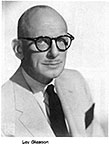
And there’s very little about the comics Gleason published. Dakin supplies a somewhat muddled history of Silver Streak, Gleason’s first (1939) comicbook, whose eponymous hero is named after the Silver Streak model of Pontiac that Gleason’s partner drove at the time. Daredevil debuted in that title and after a contorted run therein got his own comicbook in 1941.
Gleason had the good fortune to hired two men whose aptitudes were suited to producing comicbooks— Charlie Biro, who became the editor, chief writer and cover illustrator for the books, and Bob Wood, who also drew and wrote (and who bludgeoned his girlfriend to death in a hotel room in 1958 and consequently went to jail for three years). Biro and Wood worked closely enough together that they invented a byline for their joint endeavors, Woodro.
Biro was interested in youth and frequently stopped at playgrounds to talk to whatever boys might be playing ball there. Such conversations persuaded him that boys enjoy hearing about boys, so he arranged for the 1942 launch of Boy Comics (but Dakin doesn’t offer this explanation; I found it elsewhere), which, starting in the third issue, starred Crimebuster, a teenager who always wore his hockey uniform and was always accompanied by his pet monkey, Squeeks, who sat on CB’s shoulder. A popular recurring character was a fierce brute of an outlaw called Iron Jaw because his jaw has been replaced by a sort of metal clamp with sharp teeth, like those of a cartoon saw blade. (The history of Iron Jaw—his origin and his relationship with Crimebuster—is recited in loving exhaustive detail in Harv’s Hindsight for October 2010, “Champion Bad Guy.”)
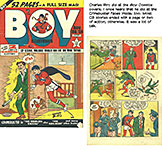 |
 |
But it was another title that made Gleason’s fortune. Crime Does Not Pay was invented by Biro and Wood while they were having a few drinks together in a neighborhood bar. That’s not quite the case: Biro was by himself, reading a newspaper, and he was astonished to see how much of the paper was devoted to reporting crime. (That’s not quite the case either; but you’ll have to read Dakin’s book to find out what really happened. Biro was indeed reading a newspaper, but it was the next day.)
And that’s when it hit him: a “true crime” comicbook would be easy to write because the stories were already there. And if there were enough reader interest in crime to support newspaper articles about it, there’d probably be interest in a comicbook on the subject, too.
Crime
Does Not Pay (1942) was not an overnight sensation, but it grew pretty
quickly in popularity: by 1947, Dakin says, Crime Does Not Pay outsold Captain
Marvel and Superman. It inspired a host of imitators, and it may
therefore have been partly responsible for the Golden Age of comicbooks ending
with a crash. Frederic Wertham was at least as interested in the bad effect on
young readers of crime comics as he was disturbed by whatever readers might do
after reading the horror titles of EC Comics. 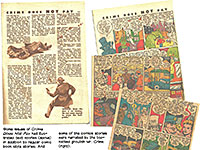
Following
his instinct and his interest in youth, Biro gave Daredevil some juvenile
sidekicks in No.13 of the title. The Little Wise Guys they were called,
although they were scarcely “little”: they were teenagers. And eventually,
Daredevil retired from his own title and left the book to the Wise Guys, whose
subsequent adventures explored growing up poor in an inner city. 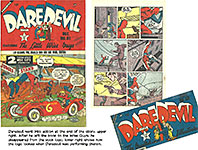
The
Wise Guys were four in number: Jock, Scarecrow, Meatball, and Peewee. Jock C. Herendeen
II was the intellectual: he wore glasses but he was a skilled athlete;
Scarecrow was the tall one with hayseed for hair, a one-time farm boy; Meatball
was the chubby one, an orphan; and Peewee was the youngest and shortest, a
one-time newsboy. In later issues (probably after Daredevil left the book),
Peewee is called Slugger. In No.15, Meatball got pneumonia and died, and his
place in the line-up went to a kid named Curly (who shaved his head). 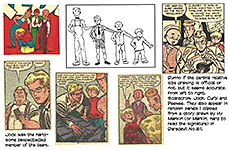
Gleason also published a western, Black Diamond Western, but Dakin doesn’t seem to know about that. The title character fought crime in the Old West wearing a black scarf that went over his head and also covered his eyes. He had a horse named Reliapon. (Say it aloud.) Many of his adventures were drawn by William Overgard.
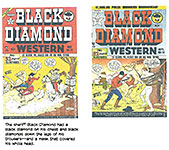 |
 |
And that’s another thing that Dakin doesn’t mention—the names of the artists most associated with the comicbooks Gleason published. In addition to Overgard, the name I remember best is Norman Maurer, who, by the late forties, was drawing the lead story in both Daredevil and Boy Comics.
Maurer
would later team with Joe Kubert to run a mail-order cartooning school
(which Kubert even later turned into a genuine classroom school in cartooning;
Kubert also drew for 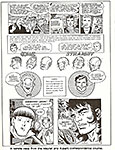
Gleason). Maurer left comics eventually, and after his 1947 marriage to Joan Howard, daughter of Moe Howard of the Three Stooges, he worked chiefly on Three Stooges projects. He also produced in 1953 the first 3-D comicbook.
But all that is somewhat beside the point.
The point is that almost none of Dakin’s tome is about comicbooks or their creation, so it’s not surprising that we learn so little about the content of the comics and how they were done.
INSTEAD, DAKIN SPENDS most of his narrative investigating the charge that his great uncle was a communist, that he was cited for contempt of Congress, and that he partially provoked the anti-comics hordes that Wertham stirred up.
All which seems exotic and vaguely criminal at first blush. But Dakin unearths some facts to remove the taint.
At one time, Gleason was president of the first industry effort to preserve itself from the lynch mob of the pearl-necklace clutchers: the Association of Comics Magazine Publishers, predecessor to the Comics Magazine Association of America, which developed a more restrictive code, one that effectively put Gleason out of business: the CMAA forbade the word “crime” from appearing in comics, and that destroyed Gleason’s best sellers, Crime Does Not Pay and its successor, 1948's Crime and Punishment.
The matters that absorb most of Dakin’s interest began with Gleason’s engagement in progressive causes. To short-cut through an often colossal tangle of narrative threads, Gleason was on the board of the Joint Anti-Fascist Refugee Committee, which had been started in the wake of the Spanish Civil War (1936-39) to provide aid to members of the Republican movement who were fleeing Spain once Franco took over and installed his fascist government.
The JAFRC soon prompted certain self-appointed right-thinking people to think it was a communist front. In the 1930s, being a communist wasn’t a crime. A lot of the American intelligentsia belonged to the Communist Party. After witnessing the collapse of capitalism in the 1929 Stock Market Crash and the ensuing Great Depression, they thought maybe communism might work now where capitalism hadn’t. Gleason was one of this persuasion, but his involvement with JAFRC wasn’t prompted by that: he just knew Spanish War refugees needed help, and JAFRC promised aid.
The communist front charge probably originated with the opposing Spanish forces in the Civil War. On one side was fascist Franco, and he was supported by Germany and Italy, both fascist governments. Opposing them were the Republicans, who practiced democratic ideals in government. And during the Civil War, they were supported by Communist Russia, which opposed fascism.
As far as his politics were concerned at the time, Gleason saw the world divided into two camps: fascism and anti-fascism. And he thought the latter preferable to the former.
Since the Republican refugees had a connection in their Civil War past with communism, JAFRC was, ipso facto, a communist front organization.
And there was Gleason, on the JAFRC board.
And he had actually been a communist. For a couple of years in the mid-1930s he had joined the American Communist Party—for the reasons I’ve suggested above (i.e., capitalism had failed; why not try communism?). But he had become disillusioned and quit, never to flirt with communism again. Except some years later when he was business manager of a magazine entitled Soviet Russia Today.
But when the House UnAmerican Activities Committee started its investigations in the early 1940s, it came upon JAFRC. Members of the board were called to testify. And HUAC demanded to see the organization’s records. The JAFRC’s executive director refused to let go of the records. And so to persuade her, all of the members of the board, regardless of their personal political convictions, were cited for contempt of Congress. Including Gleason.
At the end of this episode, the judge gave all the contemptous board members an opportunity to “purge” themselves—that is, to express a belated willingness to comply with the HUAC. Most refused and served three months in jail; Gleason took advantage of the opportunity, purged himself, and walked free.
And that was the end of that adventure. Even the condensed version I’ve supplied here displays a lot of complication. And Dakin spread the discoveries of his investigation throughout the book. His discoveries included groundless accusations against his uncle and innuendo galore. (Remember McCarthyism.)
Dakin the storyteller is quite lawyerly: he finds most of Gleason’s life in the sort of documents that he’d need to take to court if anything ever came to a trial. (Not that it would.) He’s complete, obsessively so. So we have a lot of documents to read.
But he makes it interesting. And to break up a continuous string of document quotations, he injects himself into the narrative, telling us how he acquired the family records about his great uncle and what was in them, and what he found out by reading what Gleason had written about himself for a Harvard reunion.
The book reads like a detective story. Dakin takes us step-by-step on his search for his great uncle’s life, each step yielding a new clue. And he was surprised, he said, when he visited the FBI headquarters to see if there was anything in those files about Gleason. There was. Lots. He had been a communist, remember, and the FBI’s chief, J. Edgar Hoover, hated communists.
I’m not so sure about Dakin’s politics.
He refers to a favorite hangout of Gleason’s as a club with “a seedy atmosphere and unsavory clientelle. ...” And then, immediately thereafter, he says, in reference to one of the club’s habitues: “Cab Calloway’s commercial success had much to do with the thinly veiled references to drugs and sex that pervaded his cheeky lyrics.” And he says it as if it’s wrong.
Well, maybe it is. But from these sentences, we could make the case that Dakin didn’t like liberals much. And his uncle was a ranting liberal. His associations with communism were in liberal enterprises. And he was patriot enough to have served in both World War I and World War II (not many non-professional military types could claim the same). So, what does Dakin have against Cab Calloway?
I stumbled upon no other sneering remarks about the less-than-right people, so perhaps I’m just indulging an over-active sensibility here. In any event, his sneer at Calloway stuck out like a sore fifth digit.
Some accounts about Gleason Publications assert that Gleason and Biro aimed their books deliberately at adult readers. They made a crusade of it, saying comics were not just for kids. They were breaking new ground. And that was, indeed, on their agenda along with other things—be realistic in characterization and rendering, f’instance. But aiming for adult readers provided Gleason with a defense against Wertham. It didn’t work in the long run, but it did in the short.
Speaking for myself as a onetime young reader of Daredevil and Boy Comics, I usually gave up. There was a lot of reading in those speech balloons. The stories were complicated and often character-driven, and that took explanation, which took place in what the characters said to one another. As a kid reader rather than an adult reader, I liked a little less verbiage in my comics, so I didn’t read Gleason books avidly. Adult readers probably felt differently.
But what did Lev actually do, day by day? He didn’t draw or write; so did he edit? Probably. A little here and there. And he had other publishing interests from time to time. He owned a weekly pro- New Deal newspaper that he published in his Westchester town. He published a line of heavy-breathing books with titles like Her Bed Was Never Empty, The Wench Is Willing, Devil-may-care Girl, Hotel Wife. And he had an imitation Life magazine called Picture Scoop and an imitation Reader’s Digest entitled Reader’s Scope. He was doubtless engaged with them off and on during the years he also produced comicbooks.
But we still don’t know what he did, day by day.
If you want to know how Gleason Publications produced comicbooks, who wrote and drew them and whatever excitements were involved in that—how did Maurer get his drawing assignment? how did Biro get his story ideas?—if that’s what interests you about comicbook publishing, you won’t find any of it in this book.
But if you want to know how Gleason Publications came to be and how Gleason himself got tagged a communist or cited for contempt of Congress or fought the good fight against Wertham’s followers, then this is the only book for you.
